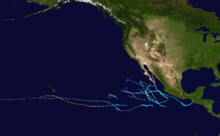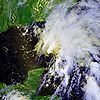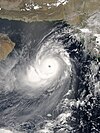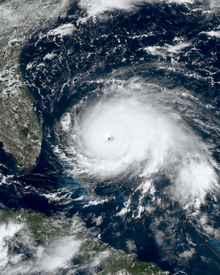Portal:Tropical cyclones
The Tropical Cyclones Portal

A tropical cyclone is a storm system characterized by a large low-pressure center, a closed low-level circulation and a spiral arrangement of numerous thunderstorms that produce strong winds and heavy rainfall. Tropical cyclones feed on the heat released when moist air rises, resulting in condensation of water vapor contained in the moist air. They are fueled by a different heat mechanism than other cyclonic windstorms such as Nor'easters, European windstorms and polar lows, leading to their classification as "warm core" storm systems. Most tropical cyclones originate in the doldrums, approximately ten degrees from the Equator.
The term "tropical" refers to both the geographic origin of these systems, which form almost exclusively in tropical regions of the globe, as well as to their formation in maritime tropical air masses. The term "cyclone" refers to such storms' cyclonic nature, with anticlockwise rotation in the Northern Hemisphere and clockwise rotation in the Southern Hemisphere. Depending on its location and intensity, a tropical cyclone may be referred to by names such as "hurricane", "typhoon", "tropical storm", "cyclonic storm", "tropical depression" or simply "cyclone".
Types of cyclone: 1. A "Typhoon" is a tropical cyclone located in the North-west Pacific Ocean which has the most cyclonic activity and storms occur year-round. 2. A "Hurricane" is also a tropical cyclone located at the North Atlantic Ocean or North-east Pacific Ocean which have an average storm activity and storms typically form between May 15 and November 30. 3. A "Cyclone" is a tropical cyclone that occurs in the South Pacific and Indian Oceans.
Selected named cyclone -
Hurricane Dorian was an extremely powerful and catastrophic Category 5 Atlantic hurricane, which became the most intense tropical cyclone on record to strike the Bahamas, and is tied with the 1935 Labor Day hurricane for the strongest landfall in the Atlantic basin in terms of maximum sustained winds. The 2019 cyclone is regarded as the worst natural disaster in the Bahamas' recorded history. With winds peaking at 185 mph (295 km/h), it was also one of the most powerful hurricanes recorded in the Atlantic Ocean in terms of 1-minute sustained winds, and the strongest since Wilma in 2005. Dorian was the fourth named storm, second hurricane, the first major hurricane, and the first Category 5 hurricane of the 2019 Atlantic hurricane season. Dorian struck the Abaco Islands on September 1 with maximum sustained winds of 185 mph (295 km/h), tying with the 1935 Labor Day hurricane for the highest wind speeds of an Atlantic hurricane ever recorded at landfall. Dorian went on to strike Grand Bahama at similar intensity, stalling just north of the territory with unrelenting winds for at least 24 hours. The resultant damage to these islands was catastrophic; most structures were flattened or swept to sea, and at least 70,000 people were left homeless. After it ravaged through the Bahamas, Dorian proceeded along the coasts of the Southeastern United States and Atlantic Canada, leaving behind considerable damage and economic losses in those regions.
Dorian developed from a tropical wave on August 24 over the Central Atlantic. The storm moved through the Lesser Antilles and became a hurricane north of the Greater Antilles on August 28. Dorian proceeded to undergo rapid intensification over the following days, before reaching its peak as a Category 5 hurricane with one-minute sustained winds of 185 mph (295 km/h) and a minimum central pressure of 910 millibars (26.87 inHg) by September 1. It made landfall in the Bahamas in Elbow Cay, just east of Abaco Island, and again on Grand Bahama several hours later, where it remained nearly stationary for the next day or so. After weakening considerably, Dorian began moving northwestward on September 3, parallel to the east coast of Florida. Dwindling in strength, the hurricane turned to the northeast the next day and made landfall on Cape Hatteras at Category 2 intensity on September 6. Dorian transitioned into an extratropical cyclone on September 7, before striking first Nova Scotia and then Newfoundland with hurricane-force winds on the next day. The storm finally dissipated near Greenland on September 10. (Full article...)Selected article -
Cyclone Freddy was the longest-lived tropical cyclone on record, beating the previous record of Hurricane John in 1994. It also has the highest accumulated cyclone energy (ACE) of any tropical cyclone on record worldwide, surpassing Hurricane Ioke in 2006. Additionally, Freddy is the only known tropical cyclone to achieve seven separate rapid intensification cycles. While in the Australian region cyclone basin, the storm quickly intensified and became a Category 4 severe tropical cyclone, before it moved into the South-West Indian Ocean basin. The Joint Typhoon Warning Center (JTWC) estimated Freddy's peak strength, equivalent to Category 5 strength on the Saffir–Simpson scale. The Météo-France (MFR) upgraded it to a very intense tropical cyclone. Freddy made its first landfall near Mananjary, Madagascar. Freddy rapidly weakened overland but re-strengthened in the Mozambique Channel. Soon afterward, Freddy made its second landfall just south of Vilankulos, Mozambique.
The remnant low of Freddy began to acquire tropical characteristics after re-emerging into the channel. Soon after, Freddy intensified, becoming a tropical cyclone. Then, Freddy made its final landfall in Quelimane, Zambezia Province, Mozambique, Freddy gradually deteriorated and last noted on 14 March. Catastrophic flooding and extensive wind damage ensued, resulting in 1,434 fatalities across Madagascar, Mozambique, Malawi, Mauritius, and Zimbabwe, making it the third-deadliest tropical cyclone recorded in the Southern Hemisphere, only behind 2019's Cyclone Idai and the 1973 Flores cyclone. Total damages are estimated to reach $655 million, making it the second-costliest cyclone in the south-west Indian Ocean after Idai in 2019.
(Full article...)Selected image -

Selected season -

The 2007 Pacific hurricane season was a well below-average Pacific hurricane season, featuring only one major hurricane. The season officially started on May 15 in the eastern Pacific and on June 1 in the central Pacific, and ended on November 30; these dates conventionally delimit the period during which most tropical cyclones form in the region. The first tropical cyclone of the season, Alvin, developed on May 27, while the final system of the year, Kiko, dissipated on October 23. Due to unusually strong wind shear, activity fell short of the long-term average, with a total of 11 named storms, 4 hurricanes, and 1 major hurricane. At the time, 2007 featured the second-lowest value of the Accumulated cyclone energy (ACE) index since reliable records began in 1971. Two tropical cyclones – Cosme and Flossie – crossed into the central Pacific basin during the year, activity below the average of 4 to 5 systems.
Impact during the season was relatively minimal. In early June, Tropical Storm Barbara moved ashore just northwest of the Mexico–Guatemala border, causing $55 million (2007 USD) in damage and 4 deaths. In late July, Cosme passed south of the island of Hawaii as a weakening tropical depression; light rain and increased surf resulted. A few days later, Dalila passed offshore the coastline of southwestern Mexico, killing 11 and causing minimal damage. Hurricane Flossie followed a similar track to Cosme in mid-August, producing gusty winds and light precipitation in Hawaii. Hurricane Henriette in early September produced torrential rainfall in southwestern Mexico, killing 6 and causing $25 million in damage. Baja California received moderate rains from Hurricane Ivo in mid-September, though no damage nor fatalities were reported. In mid-October, Tropical Storm Kiko passed just offshore the coastline of southwestern Mexico. Though no deaths were reported on the Mexico mainland, the storm capsized a ship with 30 people on board, 15 of whom were recovered dead, and 9 of whom were reported missing. Overall, the season ended with $80 million in damage and 49 deaths. (Full article...)Related portals
Currently active tropical cyclones

Italicized basins are unofficial.
- North Atlantic (2024)
- No active systems
- East and Central Pacific (2024)
- No active systems
- West Pacific (2024)
- No active systems
- North Indian Ocean (2024)
- No active systems
- Mediterranean (2023–24)
- No active systems
- South-West Indian Ocean (2023–24)
- No active systems
- Australian region (2023–24)
- No active systems
- South Pacific (2023–24)
- No active systems
- South Atlantic (2023–24)
- No active systems
Last updated: 21:50, 2 June 2024 (UTC)
Tropical cyclone anniversaries

June 2,
- 2003 - Severe Tropical Storm Nangka reached its peak intensity to the south of Taiwan.
- 2007 - As a rapidly weakening storm, Tropical Depression Barry (pictured) makes landfall over in Florida before transitioning into an extratropical cyclone. Barry only killed three people in its path with damages of only $118 thousand.
June 3,
- 1982 - Tropical Storm 02B made landfall in India near Paradip, killing 140 people and destroying half a million homes.
- 2010 - Cyclone Phet struck eastern Oman, dropping heavy rainfall across normally arid areas; the storm killed 47 people and left US$861 million in damage.
- 2014 - Tropical Storm Boris makes landfall over in Southwestern Mexico as a weak system, killing a total of six people and US$46.8 million worth of damages.

June 4
- 2006 - Cyclone Gonu (pictured) became the strongest tropical cyclone on record in the Arabian Sea, with 3-minute winds of 155 km/h (100 mph); two days later, Gonu struck the Arabian Peninsula, killing 49 people and causing about $4 billion of damage.
- 2012 - Typhoon Mawar reaches peak intensity as a Category 3 typhoon.
- 2014 - Tropical Storm Boris makes landfall over Southwestern Mexico and kills 6 people with US$46.8 million in damages.
Did you know…




- …that the Joint Typhoon Warning Center considers that Typhoon Vera (pictured) of 1986 is actually two distinct systems, formed from two separated low-level circulations?
- …that Hurricane Agatha (pictured) was the strongest Pacific hurricane to make landfall in Mexico in May since records began in 1949?
- …that Cyclone Raquel (track pictured) travelled between the Australian and South Pacific basins between the 2014–15 and 2015–16 seasons, spanning both seasons in both basins?
- …that Cyclone Amphan (pictured) in 2020 was the first storm to be classified as a Super Cyclonic Storm in the Bay of Bengal since 1999?
General images -
Since 1854, at least 102 tropical cyclones affected the U.S. state of California, including a hurricane in 1858 that produced hurricane-force winds near San Diego. This averages to roughly once a year, although events are more likely during El Niño events. Although storms have occurred as early as June and as late as October, they are most likely during the month of September. Due to cold sea surface temperatures and the typical track of most Pacific hurricanes, there has only been one recorded landfall of a tropical storm in the state – a storm in 1939 that hit Los Angeles, killing 45 people after catching many residents off guard. There have been at least 13 other deadly tropical cyclones affecting California. (Full article...)
Topics
Subcategories
Related WikiProjects
WikiProject Tropical cyclones is the central point of coordination for Wikipedia's coverage of tropical cyclones. Feel free to help!
WikiProject Weather is the main center point of coordination for Wikipedia's coverage of meteorology in general, and the parent project of WikiProject Tropical cyclones. Three other branches of WikiProject Weather in particular share significant overlaps with WikiProject Tropical cyclones:
- The Non-tropical storms task force coordinates most of Wikipedia's coverage on extratropical cyclones, which tropical cyclones often transition into near the end of their lifespan.
- The Floods task force takes on the scope of flooding events all over the world, with rainfall from tropical cyclones a significant factor in many of them.
- WikiProject Severe weather documents the effects of extreme weather such as tornadoes, which landfalling tropical cyclones can produce.
Things you can do
 |
Here are some tasks awaiting attention:
|
Wikimedia
The following Wikimedia Foundation sister projects provide more on this subject:
-
Commons
Free media repository -
Wikibooks
Free textbooks and manuals -
Wikidata
Free knowledge base -
Wikinews
Free-content news -
Wikiquote
Collection of quotations -
Wikisource
Free-content library -
Wikiversity
Free learning tools -
Wikivoyage
Free travel guide -
Wiktionary
Dictionary and thesaurus
























































